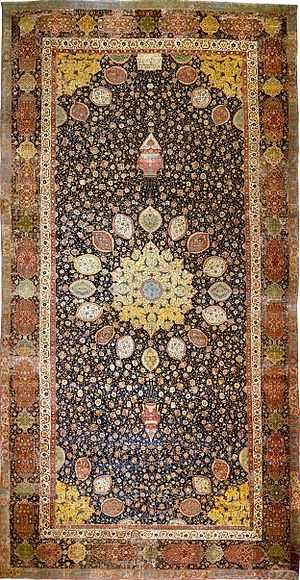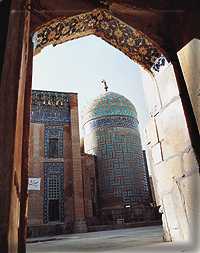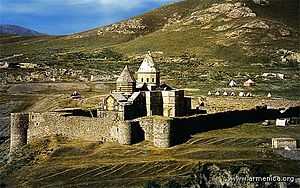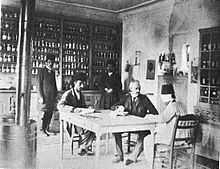Azerbaijan (Iran)

Azerbaijan or Azarbaijan (Persian: آذربایجان; Āzarbāijān; Azerbaijani: آذربایجان), also Iranian Azerbaijan, Persian Azarbaijan[1] is a region in northwestern Iran. It is also historically known as Atropatene and Aturpatakan. The region is referred by some as South Azerbaijan or Southern Azerbaijan,[2] however some scholars and sources view these terms as being irredentist and politically motivated.[3][4][5]
Etymology and usage

The name "Āzar" (Persian: آذر) means Fire and Baijan was originally known as "Pāyegān" (Persian: پایگان) meaning Guardian/Protector. (Āzar Pāyegān = "Guardians of Fire") (Persian: آذر پایگان). Such name roots back to the "Zoroastrianism" era of Iran; However, after the Arab invasion of Iran many Persian words lost their original form as in Arabic there are no letter for pronouncing "G / P / ZH / CH"; Hence "Azar Paigān" came to be known as Azarbaijan.
The name Azerbaijan itself is derived from Atropates,[6] the Satrap (governor) of Medea in the Achaemenid empire, who ruled a region found in modern Iranian Azerbaijan called Atropatene. Atropates name is believed to be derived from the Old Persian roots meaning "protected by fire."[7] The name is also mentioned in the Avestan Frawardin Yasht: âterepâtahe ashaonô fravashîm ýazamaide which translates literally to: We worship the Fravashi of the holy Atare-pata.[8] َAccording to the Encyclopedia of Islam, the name of the province was pronounced as: In Middle Persian the name of the province was called Āturpātākān, older new-Persian Ādharbādhagān آذربادگان/آذرآبادگان, Ādharbāyagān, at present Āzerbāydjān/Āzarbāydjān, Greek ᾿Ατροπατήνη, Byzantine Greek ᾿Αδραβιγάνων, Armenian Atrpatakan, Syriac Adhorbāyghān.[9] The name Atropat in Middle Persian was transformed to Adharbad and is connected with Zoroastrianism. A famous Zoroastrian priest by the name Adarbad Mahraspandan is well known for his counsels.[10] Azerbaijan, due to its numerous fire-temples has also been quoted in a variety of historic sources as being the birthplace of the prophet Zoroaster although modern scholars have not yet reached an agreement on the location of his birth.[11]
History




Pre-Islamic period
The oldest kingdom known in Iranian Azerbaijan is that of the Mannea who ruled a region southeast of Lake Urmia centered around modern Saqqez. The Manneans were a confederation of Iranian and non-Iranian groups. According to Professor Zadok:
it is unlikely that there was any ethnolinguistic unity in Mannea. Like other peoples of the Iranian plateau, the Manneans were subjected to an ever increasing Iranian (i.e., Indo-European) penetration.[12]
The Mannaeans were conquered and absorbed by an Iranian people called Matieni, and the country was called Matiene, with Lake Urmia called Lake Matianus. Matiene was later conquered by the Medes and became a satrapy of the Median empire and then a sub-satrapy of the Median satrapy of the Persian Empire.[13]
According to Encyclopædia Britannica, the Medes were an:
Indo-European people, related to the Persians, who entered northeastern Iran probably as early as the 17th century BC and settled in the plateau land that came to be known as Media.[14]
After Alexander the Great conquered Persia, he appointed (328 BC) as governor the Persian general Atropates, who eventually established an independent dynasty. The region, which came to be known as Atropatene or Media Atropatene (after Atropates), was much disputed. In the 2nd century BC, it was liberated from Seleucid domination by Mithradates I of Arsacid dynasty, and was later made a province of the Sassanid Empire of Ardashir I. Under the Sassanids, Azerbaijan was ruled by a marzubān, and, towards the end of the period, belonged to the family of Farrokh Hormizd. Heraclius, the Byzantine emperor, briefly held the region in the 7th century until peace was made with the Sassanids. After the Islamic Conquest of Iran, Arab invaders converted most of its people to Islam and made it part of the caliphate.
Islamic period
Sasanian and early Islamic period
During the Arab invasion of Iran, the name of the Spahbed of Iran, was Rostam Farrokhzad, the son of Farrukh Hormizd, who was the son of Vinduyih, the uncle of Khosrau I and brother of the Sasanian usurper Vistahm. Rustam himself was born in Azerbaijan and led the Sasanian army into battle. He is also mentioned in the Shahnameh.
The Sasanian army was defeated at the battle of al-Qādisiyyah and Rostam Farrokhzad, along with many other Sasanian veterans was killed. In 642, Piruz Khosrow, one of the Sasanian survivors during the battle of al-Qādisiyyah, fought against the Muslims at Nahavand, which was a gateway to the provinces of Azerbaijan, Armenia and Caucasian Albania. The battle was fierce but the Sasanian troops lost during the battle. This opened the gateway for Muslims into Azerbaijan. The Muslims then invaded Azerbaijan, and captured Isfandiyar, the son of Farrukhzad. Isfandiyar then promised in return for the safety of his life he would agree to surrender his estates in Azerbaijan and aid the Muslims in defeating his brother, Bahram. Bahram was then defeated, and also sought for peace. A pact was drawn according to which Azerbaijan was surrendered to Caliph Umar on usual terms of paying the annual Jizya.
Muslims settled in Azerbaijan like many parts of Iran. According to the Iranian Azerbaijani historian Ahmad Kasravi, the Muslims also settled in Azerbaijan more numerously than other provinces due to its wide and green pastures. Local revolts against the Caliphate were common and the most famous of these revolts was the Persian Khurramite movement.
Abbasid and Seljuqids
After the revolt of Babak Khorramdin who was a Zoroastrian of neo-Mazdakite background, the grip of the Abbasid caliphate on Azerbaijan weakened, allowing native dynasties to rise in Azerbaijan. Later on Azerbaijan was taken by the Kurdish Daisam and the Sallarid Marzuban. After confrontations with the local Dailamite and Kurdish populations who had already established their own dynasties and emirates in vast areas of Azerbaijan, the Seljuks dominated the region in the 11th and early 12th centuries, at which point Turkification of the native populations began. In 1136, Azerbaijan fell to the lot of the Atabakan-e-Azerbaijan and Atabakan-e-Maragheh. It was later invaded by the Khwarizm Shah Jalal ad-din until the advent of the Mongol invasions.
Mongol and Turkmen Period
The Mongols under Hulagu Khan established their capital at Maragheh. The Safina-yi Tabriz is a book that describes the general intellectual condition of Tabriz during the Ilkhanid period. After being conquered by Timur in the 14th century, Tabriz became an important provincial capital of the Timurid empire. Later, Tabriz becamse the capital of the Qara Qoyunlu empire.
Safavid, Afghan interlude, Afshars and Qajar
It was out of Ardabil (ancient Artavilla) that the Safavid dynasty arose to renew the state of Persia and establish Shi'ism as the official religion of Iran. After 1502, Azerbaijan became the chief bulwark and military base of the Safavids. In the meantime, between 1514 and 1603, the Ottomans frequently occupied Tabriz and other parts of the province. The Safavid control was restored by Shah Abbas but during the Afghan invasion (1722–8) the Ottomans recaptured Azerbaijan and other western provinces of Iran, until Nader Shah expelled them. In the beginning of the reign of Karim Khan Zand, the Azad Khan Afghan unsuccessfully revolted in Azerbaijan and later the Dumbuli Kurds of khoy and other tribal chiefs ruled various parts of the territory . With the advent of the Qajars, Azerbaijan became the traditional residence of the heirs-apparent. At this time, the final northern frontier of Iran with Russia (along the Araxes) was established in 1828 (Turkmanchay Treaty). After 1905 the representatives of Azerbaijan were very active in the Iranian Constitutional Revolution.
Modern Period
The Russian (Tsarist) army occupied Iranian Azerbaijan in 1909, and again in 1912–1914 and 1915–1918 period,the Ottoman forces occupied her in 1914–1915 and 1918–1919 periods, the Bolshevik forces occupied Iranian Azerbaijan and other parts of Iran in 1920–1921,[15] and the Soviet forces occupied Iranian Azerbaijan in 1941, creating a very short-lived autonomous, Soviet-supported state from November 1945 to November 1946,[16] which was dissolved after reunification of Iranian Azerbaijan with Iran in November of the same year. The history of Iran, especially its contemporary history has proven that Azerbaijani people are one of the most patriotic people in Iran. Iranian Nationalism is partly the product of Azerbaijani Intellectuals.[17][18] Azerbaijani provinces have played a major in the cultural and economic life of Iran in both the Pahlavi era as well as the Iranian Constitutional and Islamic revolution.
Monuments
The Iranian provinces of Azerbaijan, both West and East, possess a large number of monuments from all periods of history.[19]
Geography
Iranian Azerbaijan is generally considered the northwest portion of Iran comprising the provinces of East Azerbaijan, West Azerbaijan, and Ardabil,[20] Zanjan,[21] and some parts of Hamadan[22] and comprising an area of 122,871 square kilometres (47,441 sq mi). It shares borders with the Republic of Azerbaijan,[23] Armenia, Turkey, and Iraq. There are 17 rivers and two lakes in the region. Cotton, nuts, textiles, tea, machinery, and electrical equipment are main industries. The northern, alpine region, which includes Lake Urmia, is mountainous, with deep valleys and fertile lowlands.
The region is bounded in the north by Armenia and the Republic of Azerbaijan and in the West by Lake Urmia and Kurdish-inhabited areas of Iran, and in the East by the Talyshstan and Gilan.
Mountain
- Sabalan is an inactive stratovolcano in Ardabil province of northwestern Iran. It is the third highest mountain in Iran and has a permanent crater lake formed at its summit. Sabalan has a ski resort (Alvares) and different tourist areas such as the Sarein spa. The mountain is known for its beautiful vistas, including the Shirvan gorge, where few climbers ever venture. Elevation of Sabalan is 4,811 M.[24]
- Sahand is a massive, heavily eroded stratovolcano in northwestern Iran. At 3,707 m (12,162 ft), it is the highest mountain in the Iranian province of East Azarbaijan.
- Eynali is a small mountain range in north of Tabriz, Iran. The range has a couple of peaks including Eynali (1800 m), Halileh (1850 m), Pakeh-chin (1945 m), Bahlul (1985 m) and the highest one Dand (2378 m).[25]
- Mount Bozgush and Ağ Dağ is a 3,306 metres (10,846 ft)[26] volcanic mountain 20 km (10 mi) south of Sarab and north of Mianeh, East Azarbaijan Province, Iran. Tulips are cultivated on the rich volcanic soil of Mount Bozgush, and medicinal herbs such as pennyroyal, thyme, borage, nettle and liquorice grow wild on the mountain's slopes. Mount Bozgush is a stratovolcano composed mostly of andesite.
-

Artificial forest of Eynali
River

Important rivers in Azerbaijan include:
- basin Urmia Lake: Aji Chay, Quri Chay, Zarriné-Rūd, Gadar River etc.
- basin Caspian Sea: Qizil-uzan and Aras River (Zangmar River)
biosphere reserve

Arasbārān in the former Qaradagh, is a UNESCO registered biosphere reserve (since 1976) and an Iranian Dept. of Environment designated "Protected Area" in East Azarbaijan Province, Iran, with a varying altitude from 256m in the vicinity of Aras River to 2896m and covers an area of 78560 hectares. The biosphere is also home for 23,500 nomads who are living in transition buffer in 2000 altitude.[27] Arasbaran is confined to Aras River in the north, Meshgin Shahr County and Moghan in the east, Sarab County in the south, and Tabriz and Marand counties in the west.
Lake
- Urmia Lake is a salt lake in northwestern Iran near Iran's border with Turkey. The lake is between the Iranian provinces of East Azerbaijan and West Azerbaijan, west of the southern portion of the similarly shaped Caspian Sea. It is the largest lake in the Middle East,[28]
- Shorabil Lake is a lake located in a hilly area south of the Iranian city of Ardabil. Ardabil University is located near the lake.[29][30]
- Gori Lake is a small fresh to brackish lake in the uplands of East Azarbaijan Province in northwestern Iran. Together with the adjacent reed marshes it is an important breeding area for waterfowl. A 1.2 km² site was designated as a Ramsar Convention wetland protection site on 23 June 1975.
-

The smallest island of Lake Urmia, Osman fist.[1]
-
.jpg)
Shorabil Lake at night
-
Marmishu Lake in Urmia County
-

Galghanlou Lake in Khan Kandi, Germi
Cite error: There are <ref> tags on this page, but the references will not show without a {{reflist}} template (see the help page).
Plain
Mugan plain is a plain in northwestern Iran and the southern part of the Republic of Azerbaijan. The highest density of irrigation canals is in the section of the Mugan plain which lies in the Republic of Azerbaijan. It is located on the bank of the Aras river extending to Iran. It contains highest density of irrigation canals is in the Mugan plain.[31]
Politics
in Azerbaijan
| Province | Governor-general | Representative of the Supreme Leader | Province | Governor-general | Representative of the Supreme Leader |
|---|---|---|---|---|---|
in Assembly of Experts
84 people are members of Assembly of Experts, that 11 of them are representative of Azerbaijan region. Ali Meshkini from Meshgin Shahr[32] in the Ardabil Province was Chairmen of the Assembly of Experts since 1983 to 2007.
- 5 representative of East Azerbaijan.
- 3 representative of West Azerbaijan.
- 2 representative of Ardabil Province.
- 1 representative of Zanjan Province.
| Name | Province | Name | Province | Name | Province | Name | Province |
|---|---|---|---|---|---|---|---|
in Islamic Consultative Assembly
290 person are members of Islamic Consultative Assembly, that 45 of them are representative of Azerbaijan region.
- Electorate According to County
- [33]
- East Azerbaijan
- 20
- Tabriz, Osku, Azarshahr
- 6
- Meyaneh
- 2
- Kaleybar, Khoda Afarin
- 1
- Marand, Jolfa
- 1
- Sarab
- 1
- Bostanabad
- 1
- Maragheh, Ajabshir
- 1
- Hashtrud, Charuymaq
- 1
- Kaleybar
- 1
- Varzagan
- 1
- Ahar, Heris
- 1
- Shabestar
- 1
- Malekan
- 1
- Bonab
- 1
- West Azerbaijan
- 13
- Urmia
- 3 (1 person Kurd)
- Miandoab, Shahin Dezh, Takab
- 2
- Khoy, Chaypareh
- 1
- Mahabad
- 1 (Kurd)
- Bukan
- 1 (Kurd)
- Maku, Poldasht, Showt, Chaldoran
- 1
- Nagadeh, Oshnavieh
- 1 (Kurd)
- Salmas
- 1
- Piranshahr, Sardasht
- 1 (Kurd)
- Assyrian
- 1 (For all country)
- Ardabil Province
- 7
- Ardabil, Nir, Namin, Sareyn
- 3
- Germi
- 1
- Meshgin Shahr
- 1
- Khalkhal, Kowsar
- 1
- Bileh Savar, Parsabad
- 1
in cabinet of Iran
- Mohammadreza Nematzadeh: Minister of Industries and Business[34]
- Hamid Chitchian: Minister of Energy[35]
- Ms. Shahindokht Molaverdi: vice president of Iran the section Women and Family Affairs.[36][37]
Consulate
| Country | Name | City | Province | Country | Name | City | Province |
|---|---|---|---|---|---|---|---|
Military
| Type | Name | City | Province | Type | Name | City | Province |
|---|---|---|---|---|---|---|---|
Economy
Companies and industries
Industries include machine tools, vehicle factories, oil refinery, petrochemical complex, food processing, cement, textiles, electric equipment, and sugar milling. Oil and gas pipelines run through the region. Wool, carpets, and metal ware are also produced. In some factories and major companies in Azerbaijan include:
- Iran Tractor Manufacturing Company: is a tractor manufacturing company with headquarters in Tabriz.[41] Iran Tractor Manufacturing Company is currently exporting 13 different products to ten countries.[41] and has qualified for ISO 9001, and has also received rewards regarding quality and exporting.[41]
- Goldstone Tires: operating under the brand Goldstone Tires is an Iranian tire manufacturer for automobiles, commercial trucks, light trucks, SUVs, race cars, airplanes, and heavy earth-mover machinery in Ardabil. Artawheel Tire is currently the largest non-government owned tire manufacturer in Iran by marketshare.[42] The company currently has agreements with Iran Khodro to develop tires for the Peugeot 206 Models[43]
- Rakhsh Khodro Diesel: is an Iranian truck manufacturer established in 2005 and located in Tabriz. This company is strategic partner of Kamaz of Russia, JAC and Jinbei of China and Maz-Man of Belarus and produces Kamaz trucks, JAC light trucks and its own designed minibus. Its headquarter is in Tabriz.
- Iran Khodro: is the leading Iranian vehicle manufacturer, with headquarters in Tehran.[44] The company's original name was Iran National. In addition to Tehran, largest car factory in Iran have 5 automobile factories throughout the Iran. and "Iran Khodro - Tabriz" have produces capacity 61,000[45] Bardo Pick-up[46] in year.
- Tabriz International Exhibition Center: which is a complex with vast exhibition infrastructures, is located in the eastern part of Tabriz. It holds tens of exhibitions based on a yearly schedule. There are 46 exhibitions scheduled for the current Iranian year. The most famous fair is TEXPO, which is a general trade fair.
- Aras Free Zone: is situated in East Azarbaijan province, in the north-west of Iran, adjacent to Nakhchivan Autonomous Republic, Armenia and the Republic of Azerbaijan.[47] Existence of the greenhouse town in the AFTZ, which has been built upon cooperation of Agricultural Jihad Ministry, has paved the ground for presence of investors in the arena of planting hydroponic products.[47] The 500-megawatt combined cycle power plant project which is currently underway in AFTZ as a joint investment venture with foreign parties.[47]
- and other major petrochemical companies, oil refineries and industries are including Machine works Company of Tabriz, Iranian Diesel Engine Manufacturing (IDEM), Tabriz Oil Refinery, Tabriz Petrochemical, Copper Mine Songon and etc.
Rug and Carpet
The Ardabil Carpet and Tabriz rug the best kind of Iranian carpet. Now 40 percent of Iranian carpet exports are carried through East Azarbaijan.[48] Azerbaijani carpets and rugs are important:
- Ardabil Carpet: is either of a pair of two famous Iranian carpets in the collections of the Victoria and Albert Museum in London and the Los Angeles County Museum of Art.[49]
- Tabriz rug is a type in the general category of Iranian carpets[50][51][52] from the city of Tabriz, the capital city of East Azarbaijan Province in north west of Iran.
- Heriz rug are Persian rugs from the area of Heris, East Azerbaijan in northwest Iran, northeast of Tabriz. Such rugs are produced in the village of the same name in the slopes of Mount Sabalan.
- Ardabil rug originate from Ardabil located in the province of Ardabil Province in northwestern Iran, 639 kilometers from Tehran. Ardabil has a long and illustrious history of Azerbaijani carpet weaving. The reign of the Safavid Dynasty in the 16th and 17th centuries represented the peak of Azerbaijani carpet making in the region.
- Karadagh rug or Karaja rug handmade in or near the village of Qarājeh (Karaja), in the Qareh Dāgh (Karadagh) region of Iran just south of the Azerbaijan border, northeast of Tabrīz. The best-known pattern shows three geometric medallions that are somewhat similar to those in Caucasian carpets. The central one has a latch-hooked contour and differs in colour from the others, which are eight-pointed stars.[53]
Agriculture
Grains, fruits, cotton, rice, nuts, and tobacco are the staple crops of the region.
Demographics
People
Iranian Azerbaijanis, a Turkic-speaking people of mixed Caucasian, Iranian and Turkic origin,[54] who number 16a[55][56] — 17b[57] — 21.6c[58] — 24 percentd[59] and also 15e[60] — 15.5f[61] — 16 milliong[62] of Iran's population. in the Azerbaijan region, the population consists mainly of Azerbaijanis[20] Azeris are the largest group in Iranian Azerbaijan and, while Kurds are the second largest group, and a majority in many cities of the West Azerbaijan Province.[63] Iranian Azerbaijan is one of the richest and most densely populated regions of Iran. Many of these various linguistic, religious, and tribal minority groups, and Azeris themselves have settled widely outside the region.[64] The majority Azeris are followers of Shi'a Islam. The Iranian Azerbaijanis, mainly resides in the northwest provinces: Included Iranian Azerbaijan provinces (East Azerbaijan, West Azerbaijan, Ardabil, and Zanjan) as well as regions of North[65] to Hamadan County[66] and Shara District[66] in the East Hamadan Province, some regions Qazvin Province[21][67] and also Azerbaijani minorities living in Markazi,[68] Kordestan,[69] Gilan[70][71] and Kermanshah.h[72]
Smaller groups such as Armenians, Assyrians, Talyshs, Jews, and Persians also inhabit the region.[citation needed]
Emigration
Azerbaijani people mostly live in northwest parts of Iran. But large Azerbaijani populations can be found in Khorasan[73] especially Mashhad.[74] and central Iran due to internal migration to Tehran,[73] Karaj,[67] Qum[73] wherever they have settled they have become prominent not only among urban and industrial working classes but also in commercial, administrative, political, religious, and intellectual circles.[73] for example Azerbaijanis make up 25%[75]– 33%[21][67] of Tehran and Tehran Province's population. They are the largest ethnic groups after Persians in Tehran and the Tehran Province.[76] also Governor of Tehran, is Hossein Hashemi[77] from Sarab in East Azerbaijan.[78] and Ali Khamenei Supreme Leader of Iran was born Mashhad, origin Azeri[79][80][81] from Tabriz.
Population
According to the population census of 2012, the four provinces of East Azerbaijan (2012 pop. 3,724,620), West Azarbaijan (2012 pop. 3,080,576), Zanjan (2012 pop. 1,015,734), and Ardabil (2012 pop. 1,248,488) have a combined population of 9 million people.[82]
Administrative divisions

Azerbaijan's major cities are Tabriz[21][67] (the capital of East Azerbaijan), Urmia[21][67] (the capital of West Azerbaijan), Zanjan[21][67] (the capital of Zanjan Province), Ardabil[21][67] (the capital of Ardabil Province) and Major cities non-capital of Province's Azerbaijan are Khoy and Maragheh.[21][67]
| Rank | Name | Image | County | Province | Population (County) | Rank | Name | Image | Country | Province | Population (County) |
|---|---|---|---|---|---|---|---|---|---|---|---|
 | | |
 | | | ||||||
 | | |
 | | | ||||||
 | | |
 | | | ||||||
 | | |
 | | | ||||||
Culture

Azeris are culturally very close to the rest of the Iranians though their language is Turkic. The people of Azerbaijan have similar DNA to other Iranian peoples[83][84] as well as their religion which is Shi'a Islam, which sets them apart from other Turkic speakers (who are mostly Sunni Muslims). Azeris celebrate Nouruz for the turn of the new Iranian year, the arrival of spring. Azerbaijan has a distinct music in Iran. Many local dances and folk music continue to survive among the various peoples of the provinces. Although Azerbaijani language is not an official language it is widely used, mostly in an oral tradition, among the Azeris in Iran.
Literature
Many poets that came from Azerbaijan wrote poetry in both Persian and Azerbaijani. Renowned poets in Azerbaijani language are Nasimi, Shah Ismail I (who was known with the pen-name Khatai), Fuzuli, Nasimi and Jahan Shah were probably born outside what is now Iranian Azerbaijan. Azerbaijani was the dominant language of the ruling dynasties of the Turkic rulers of the area such as the Ak Koyunlu,[85] Kara Koyunlu[86] and later it was used in the Safavid for court, until Isfahan became capital[87] and religious dignitaries, military.[88][89] In the 16th century, Azerbaijani literature further flourished with the development of Ashik (Azerbaijani: Aşıq) poetic genre of bards. During the same period, under the pen-name of Khatāī (Arabic: خطائی for sinner)[90] Shah Ismail I wrote about 1400 verses in Azerbaijani,[91] which were later published as his Divan. A unique literary style known as qoshma (Azerbaijani: qoşma for improvisation) was introduced in this period, and developed by Shah Ismail and later by his son and successor, Shah Tahmasp and Tahmasp I.[85] In the span of the 17th century, 18th and 19th century, Fizuli's unique genres as well Ashik poetry were taken up by prominent poets and writers such as Qovsi Tabrizi, Shah Abbas Sani, Khasta Qasim, Mirza Fatali Akhundov, Seyid Abulgasim Nabati, Ali Mojuz and others.
An influential piece of post-World War II Azerbaijani poetry, Heydar Babaya Salam (Greetings to Heydar Baba) was written by Azeri poet Mohammad Hossein Shahriar who had already established himself as a notable. This poem, published in Tabriz in 1954 and written in colloquial Azerbaijani, became popular among Iranians and the people of Azerbaijan. In Heydar Babaya Salam, Shahriar expressed his identity as an Iranian Azerbaijani attached to his homeland, language, and culture. Heydar Baba is a hill near Khoshknab, the native village of the poet.
Azerbaijan is mentioned favorably on many occasions in Persian literature by Iran's greatest authors and poets. Examples:
گزیده هر چه در ایران بزرگان
زآذربایگان و ری و گرگان
All the nobles and greats of Iran,
Choose from Azerbaijan, Ray, and Gorgan.
—Vis o Ramin
از آنجا بتدبیر آزادگان
بیامد سوی آذرآبادگان
From there the wise and the free,
set off to Azerbaijan
—Nizami
به یک ماه در آذرآبادگان
ببودند شاهان و آزادگان
For a month's time, The Kings and The Free,
Would choose in Azerbaijan to be
—Ferdowsi
UNESCO World Heritage Sites
Nine historical sites in Azerbaijan have been designated as World Heritage Sites by UNESCO:
- Bazaar of Tabriz: is one of the oldest bazaars in the Middle East and the largest covered bazaar in the world. The bazaar was declared to be a World Heritage Site in July 2010.[92][93]
- Sheikh Safi al-Din Khānegāh and Shrine Ensemble: is the tomb of Sheikh Safi-ad-din Ardabili located in Ardabil, Iran.[94] In 2010, it was registered on the UNESCO World Heritage List.[95]
- Takht-e Soleymān: literally the Throne of Solomon, in earlier ancient periods known as Shiz or Adur Gushnasp,[96] literally the Fire of the Warrior Kings) is an archaeological site in West Azarbaijan. It lies midway between Urmia and Hamadan, very near the present-day town of Takab,
- Soltaniyeh: located near Zanjan, 240 kilometres (150 mi) to the north-west of Tehran, used to be the capital of Mongol Ilkhanid rulers of Persia in the 14th century. Its name translates as The Imperial. In 2005, UNESCO listed Soltaniyeh as one of the World Heritage Sites. The road from Zanjan to Soltaniyeh extends until it reaches to the Katale khor cave.
- Five churchs in Azerbaijan: St. Thaddeus Monastery, Saint Stepanos Monastery, Church of the Holy Mother of God, Darashamb, Church of Sour Sour and Church of Chupan are World Heritage Sites.
-

Soltanieh Dome in Soltaniyeh
Colleges and universities
There are many universities in Azerbaijan, included units and centers: public university and private university Islamic Azad University, Payame Noor University, Nonprofit educational institutions, University of Applied Science and Technology.
Public universities in the area include:
| Row | Colleges and universities | City | Province | |
|---|---|---|---|---|
| 1 | Tabriz University | Tabriz | East Azerbaijan | |
| 2 | Urmia University | Urmia | West Azerbaijan | |
| 3 | Mohaghegh Ardabili University | Ardabil | Ardabil Province | |
| 4 | Zanjan University | Zanjan | Zanjan Province | |
| 5 | Sahand University of Technology | Tabriz | East Azerbaijan | |
| 6 | Urmia University of Technology | Urmia | West Azerbaijan | |
| 7 | Institute for Advanced Studies in Basic Sciences (IASBS) | Zanjan | Zanjan Province | |
| 8 | Tabriz University of Medical Sciences | Tabriz | East Azerbaijan | |
| 9 | Urmia University of Medical Sciences | Urmia | West Azerbaijan | |
| 10 | Ardabil University of Medical Sciences | Ardabil | Ardabil Province | |
| 11 | Zanjan University of Medical Sciences | Zanjan | Zanjan Province | |
| 12 | Tabriz Islamic Arts University | Tabriz | East Azerbaijan | |
| 13 | Azarbaijan Shahid Madani University | Azarshahr | East Azerbaijan | |
| 14 | University of Maragheh | Maragheh | East Azerbaijan | |
| 15 | Maragheh observatory | Maragheh | East Azerbaijan |
-
Mohaghegh Ardabili University main entrance
-

Zanjan University
-

Shahid Chamran Hall (central library) — of Urmia University
-

Behnam House is part of the School of Architecture of Tabriz Islamic Arts University
-
Allameh building of Sahand University
-

Tabriz University Tower Clock
Architecture
Azeri style is a style (sabk) of architecture when categorizing Iranian architecture development in Azerbaijan history. Landmarks of this style of architecture span from the late 13th century (Ilkhanate) to the appearance of the Safavid Dynasty in the 16th century CE.[97]
Transportation
Air

Ata Airlines is an airline based in Tabriz, Iran. Operates scheduled domestic services and international services in the Middle East, as well as charter services including Europe. Its main base is Tabriz International Airport. in this airplane company is in Azerbaijan with Eram Air.
Commercial and Passenger airports in Azerbaijan:
| Row | Airport | City | Province | |
|---|---|---|---|---|
| 1 | Tabriz International Airport | Tabriz | East Azerbaijan | |
| 2 | Urmia Airport | Urmia | West Azerbaijan | |
| 3 | Ardabil Airport | Ardabil | Ardabil Province | |
| 4 | Zanjan Airport | Zanjan | Zanjan Province | |
| 5 | Sahand Airport | Bonab | East Azerbaijan | |
| 6 | Khoy Airport | Khoy | West Azerbaijan | |
| 7 | Parsabad-Moghan Airport | Parsabad | Ardabil Province |
Railway

Tabriz Railway Station is a was founded in Tabriz, in 1917; the current building was built during second Pahlavi era by Iranian architect Heydar Ghiaï-Chamlou. The first railroad arriving to Tabriz had been built by Russian. The railway started from Jolfa, a city on the border of Iran and the modern Republic of Azerbaijan.
Active lines this railway included: Tabriz — Tehran, Tabriz — Nakhchivan Autonomous Republic and Tabriz — Turkey.
Metro

Metro being built in the Tabriz City since 2001. this metro have 5 line (4 line is main, 1 line is vicinity) and the total length is 75 kilometers. one's line Tabriz metro El-golu in southeast connect to Laleh district in the southwest.[98]
Roads
| type | Number Road | Distance (Km) | City of Origin | City of Destination | Location | Image |
|---|---|---|---|---|---|---|
| Freeways | Freeway 2 (Iran) | 600 | Tehran | Tabriz (Az) |  |
 |
| Highways and Roads | Road 11 (Iran) | 325 | Jolfa (Az) | Baneh | 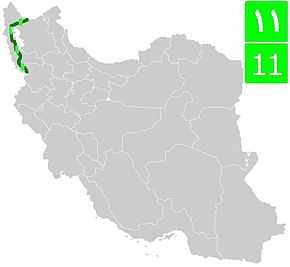 |
|
| Highways and Roads | Road 12 (Iran) | 572 | Bazargan (Az) | Bileh Savar (Az) | .jpg) |
|
| Highways and Roads | Road 14 (Iran) | 460 | Razi, Ardabil (Az) | Salmas (Az) | .jpg) |
|
| Highways and Roads | Road 16 (Iran) | 428 | Astara | Serow (Az) | .jpg) |
 |
| Highways and Roads | Road 21 (Iran) | 978 | Ilam | Jolfa (Az) |  |
|
| Highways and Roads | Road 22 (Iran) | 428 | Sarakhs | Khalkhal (Az) |  |
 |
| Highways and Roads | Road 23 (Iran) | 390 | Miandoab (Az) | Hamadan | 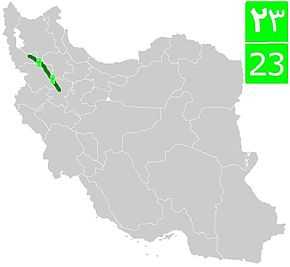 |
|
| Highways and Roads | Road 24 (Iran) | 142 | Hashtrud (Az) | Bonab (Az) | 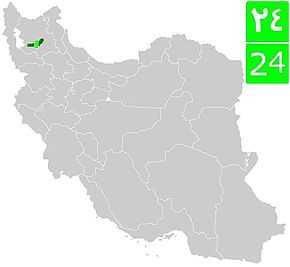 |
|
| Highways and Roads | Road 26 (Iran) | 151 | Miandoab (Az) | Piranshahr (Az) |  |
|
| Highways and Roads | Road 27 (Iran) | 245 | Khomarlu (Az) | Tabriz (Az) |  |
|
| Highways and Roads | Road 31 (Iran) | 539 | Parsabad (Az) | Manjil |  |
|
| Highways and Roads | Road 32 (Iran) | 880 | Tehran | Bazargan (Az) |  |
|
| Highways and Roads | Road 33 (Iran) | 155 | Ardabil (Az) | Bileh Savar (Az) | 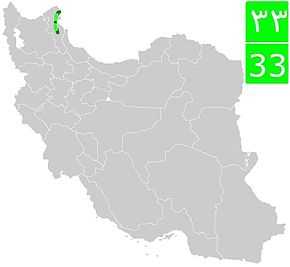 |
|
| Highways and Roads | Road 35 (Iran) | 155 | Zanjan (Az) | Khorramabad |  |
Media

TV and radio
- Sahand TV from Tabriz
- Eshragh TV from Zanjan
- Sabalan TV from Ardebil
- West Azerbaijan TV from Urmia
Newspapers
|
|
Sport

Top sport clubs
Representatives of Azerbaijani in the top leagues.
- Football
- Futsal
- Volleyball
- Basketball
- Cycling Team
Cycling Tour
Azerbaijan International Cycling Tour: is an annual professional road bicycle racing stage race held in Iran since 1986, named after Azerbaijan, Iran. The race is categorized by International Cycling Union (UCI) as a 2.2 category race as part of the Asia Tours.
Sports facilities
Large and important stadiums:
See also
| Wikisource has the text of the 1911 Encyclopædia Britannica article Azerbāïjān. |
|
Notes
- ^a Reporting and estimation World Factbook and Library of Congress
- ^b Reporting and estimation Looklex Encyclopaedia
- ^c Reporting and estimation New America Foundation
- ^d Reporting and estimation Minority Rights Group International
- ^e Reporting and estimation Britannica Encyclopaedia
- ^f Reporting and estimation Ethnologue
- ^g Reporting and estimation Encyclopædia Iranica, The number of Turkic speakers in Iran today is estimated about 16 million, The majority are ethnic Azeris
- ^h Just in Sonqor County
References
- ↑ James Minahan. "Miniature Empires", Published by Greenwood Publishing Group, 1998.
- ↑ Brown, Cameron S. 2002 (Dec.). "Observations from Azerbaijan." Middle East Review of International Affairs: v. 6, no. 4, (LINK)
- ↑ Michael P. Croissant, "The Armenia-Azerbaijan Conflict: Causes and Implications", Praeger/Greenwood, 1998. excerpt from pg 61: "During the Soviet-era historical revisionism and myth-building intended to denounce imperialism, the notion of a "northern" and "southern" Azerbaijan was created and propagated throughout USSR. It was charged that the "two Azerbaijanis" once united were separated artificially by conspiracy between imperial Russia and Iran".
- ↑ Ethnic Conflict and International Security, Edited by Michael E. Brown, Princeton University Press, 1993
- ↑ Bert G. Fragner, ‘Soviet Nationalism’: An Ideological Legacy to the Independent Republics of Central Asia ’ in” in Van Schendel, Willem(Editor) . Identity Politics in Central Asia and the Muslim World: Nationalism, Ethnicity and Labour in the Twentieth Century. London , GBR: I. B. Tauris & Company, Limited, 2001. Excerpt from pg 24: "Under Soviet auspices and in accordance with Soviet nationalism, historical Azerbaijan proper was reinterpreted as 'Southern Azerbaijan', with demands for liberation and, eventually, for 're'-unification with Northern (Soviet) Azerbaijan a breathtaking manipulation. No need to point to concrete Soviet political activities in this direction, as in 1945–46 etc. The really interesting point is that in the independent former Soviet republics this typically Soviet ideological pattern has long outlasted the Soviet Union."
- ↑ Atroapates. Encyclopedia Iranica
- ↑ Encyclopædia Iranica, "ATROPATES" M. L. Chaumont.
- ↑ FRAWARDIN YASHT ("Hymn to the Guardian Angels") Translated by James Darmesteter (From Sacred Books of the East, American Edition, 1898)
- ↑ Minorsky, V.; Minorsky, V. "Azerbaijan" Encyclopaedia of Islam. Edited by: P. Bearman, Th. Bianquis, C.E. Bosworth, E. van Donzel and W.P. Heinrichs. Brill
- ↑ R. C. Zaehner, The Teachings of the Magi, London, 1956, p. 101
- ↑ G. Gnoli, Zoroaster's time and homeland, Naples, 1980
- ↑ MANNEA by R. Zadok in Encyclopaedia Iranica
- ↑ Maps showing Matiene and Lake Matianus
- ↑ "Mede". Encyclopædia Britannica. 2007. Encyclopædia Britannica Online. 12 February 2007 <http://www.britannica.com/eb/article-9051719>
- ↑ Younes Parsa Benab, "The Gilan Soviet Republic and Azadistan in Iranian Azerbaijan (1917–1921)", accessed April 2, 2007
- ↑ Jessup, John E. (1989). A Chronology of Conflict and Resolution, 1945–1985. New York: Greenwood Press. ISBN 0-313-24308-5.
- ↑ For more information see: Ali Morshedizad,Roshanfekrane Azari va Hoviyate Melli va Ghomi (Azari Intellectuals and Their Attitude to National and Ethnic Identity (Tehran: Nashr-e Markaz publishing co., 1380)
- ↑ Cold War International History Project Virtual Archive 2.0 Collection: 1945–46 Iranian Crisis
- ↑ Kleiss, Wolfram. "AZERBAIJAN xii. MONUMENTS". Encyclopædia Iranica. Retrieved 2013-12-27.
- ↑ 20.0 20.1 "Azerbaijan". Encyclopædia Britannica. 2009-03-09. (excerpt:"geographic region that comprises the extreme northwestern portion of Iran. It is bounded on the north by the Aras River, which separates it from independent Azerbaijan and Armenia; on the east by the Iranian region of Gīlān and the Caspian Sea; on the south by the Iranian regions of Zanjān and Kordestān; and on the west by Iraq and Turkey. Azerbaijan is 47,441 square miles (122,871 square km) in area.")
- ↑ 21.0 21.1 21.2 21.3 21.4 21.5 21.6 21.7 "Country Study Giude-Azerbaijanis". STRATEGIC INFORMATION AND DEVELOPMENTS-USA. Retrieved 13 August 2013.
- ↑ Dizadji, H. (2010). Journey from Tehran to Chicago. Trafford Publishing. p. 105. ISBN 1-4269-2918-8.
- ↑ M. N. POGREBOVA, Encyclopedia Iranica, ARCHEOLOGY. viii. NORTHERN AZERBAIJAN (REPUBLIC OF AZERBAIJAN), 16 June 2004
- ↑ "Iran: 54 Mountain Summits with Prominence of 1,500 meters or greater" Peaklist.org. Retrieved 2011-11-21.
- ↑ East Azerbaijan Mountaineering Confedration
- ↑ National Geographic Society (2005) National Geographic Atlas of the World (8th ed.) Washington, DC, ISBN 0-7922-7542-X
- ↑ http://www.unesco.org/mabdb/br/brdir/directory/biores.asp?code=IRA+01&mode=all Profile at UNESCO biosphere reserve directory
- ↑ "Britanica". Britannica.com. Retrieved 4 September 2011.
- ↑ "Shorabil Lake". tripadvisor.in. Retrieved 18 September 2013.
- ↑ "Shorabil Lake, Ardabil, South Azerbaijan". youtube.com. Retrieved 18 September 2013.
- ↑ Tapper, Richard. "MOḠĀN". Encyclopædia Iranica. Retrieved 2013-12-27.
- ↑ "The chairman of the Assembly of Experts died" (in Persian). Radio Zamaneh. 2007-08-30. Retrieved 2007-08-08.
- ↑ "جدول مدارک تحصیلی و سوابق اجرایی اعضای 14 کمیسیون مجلس نهم". Fars News Agency. Retrieved 22 October 2013.
- ↑ News Hamshahri Online
- ↑ "15 of 18 Proposed Iranian Cabinet Ministers Devoted by Parliament". Mojnews. 16 August 2013. Retrieved 29 August 2013.
- ↑ "شهیندخت مولاوردی، معاون حسن روحانی در امور زنان شد". Persian Deutsche Welle. 13 August 2013. Retrieved 8 October 2013.
- ↑ "Ms Molaverdi appointed as vice president for women, family Affairs". President of Iran Website. 13 August 2013. Retrieved 8 October 2013.
- ↑ "تبریز، میهمان رئیس جمهور ترکیه". ISNA. Retrieved 2013-10-20.
- ↑ "مهمت بولوت سرکنسول جدید ترکیه در ارومیه ، با استاندار دیدار کرد". Asar-e Omid News Agency. Retrieved 2013-10-20.
- ↑ "Ə.F.Əlizadənin İran İslam Respublikasının Təbriz şəhərində Azərbaycan Respublikasının baş konsulu təyin edilməsi haqqında Azərbaycan Respublikası Prezidentinin Sərəncamı". Presidential Azerbaijan Website. Retrieved 2013-10-20.
- ↑ 41.0 41.1 41.2 Official website
- ↑ http://www.goldstoneir.com/English/index.php
- ↑ http://www.iranexportsmagazine.com/Archive/mag%2066/industry66.html
- ↑ "Internet Archive Wayback Machine". Web.archive.org. 2008-06-17. Archived from the original on 2008-06-17. Retrieved 2011-05-29.
- ↑ "۲۰ هزار دستگاه وانت بار در ايران خودرو تبريز توليد شد". Islamic Republic News Agency. Retrieved 2013-10-19.
- ↑ "Bardo". Iran Khodro Website. Retrieved 2013-10-19.
- ↑ 47.0 47.1 47.2 http://www.iran-daily.com/1389/4/13/MainPaper/3720/Page/4/Index.htm#
- ↑ "احداث موزه فرش و ايجاد پايانه صادراتي فرش در تبريز". Fars News Agency. Retrieved 2013-10-19.
- ↑ Hillyer, L., and Pretzel, B., The Ardabil Carpet - a new perspective, V&A Museum accessed January 29, 2007.
- ↑ Along with Kashan, Kerman, Herat, and every major city of Iran...
- ↑ Jacoby, Heinrich (1952). How to know Oriental carpets and rugs. Allen & Unwin. p. 15. "Persian carpets: Tabriz, Ramadan, ..."
- ↑ Jacobsen, Charles W. (2007). Facts about Oriental Rugs. READ BOOKS. p. 2. ISBN 1-4067-0467-9. ""Different weaves...Persian rugs..Bakhtiari..Kashan..Lorestan..Shiraz..Tabriz.."
- ↑ "Karaja rug". Britannica Encyclopaedia. Retrieved 2013-10-17.
- ↑ Minorsky, V.; Minorsky, V. "(Azerbaijan). Encyclopaedia of Islam. Edited by: P. Bearman, Th. Bianquis, C.E. Bosworth, E. van Donzel and W.P. Heinrichs. Brill
- ↑ CIA, CIA. "CIA World Factbook". Retrieved 2012-05-27.
- ↑ Library of Congress, Library of Congress – Federal Research Division. "Ethnic Groups and Languages of Iran". Retrieved 2009-12-02. 16% estimated in 2012
- ↑ "Iran / Peoples". Looklex Encyclopaedia. Retrieved 16 October 2013.
- ↑ "Results a new nationwide public opinion survey of Iran". New America Foundation. June 12, 2009. Retrieved 13 August 2013.
- ↑ "Azeris". Minority Rights Group International. 2009. Retrieved 16 October 2013.
- ↑ "Azerbaijani". Encyclopædia Britannica. Retrieved 17 October 2013.
- ↑ "Azerbaijani, South # A language of Iran". Ethnologue. 2013. Retrieved 17 October 2013.
- ↑ "IRAN v. PEOPLES OF IRAN (1) A General Survey". Encyclopædia Iranica. March 29, 2012. Retrieved 17 October 2013.
- ↑ Keith Stanley McLachlan, "The Boundaries of Modern Iran ", Published by UCL Press, 1994. pg 55
- ↑ Encyclopaedia Iranica, page 243 = accessed January 9, 2007]
- ↑ Parviz Aḏkāʾi and EIr. "HAMADĀN i. GEOGRAPHY". Encyclopædia Iranica. Retrieved 2013-10-21.
- ↑ 66.0 66.1 "زبانهاي رايج و نوع گويش در شهرستان". Governor of Hamadan. Retrieved 21 October 2013.
- ↑ 67.0 67.1 67.2 67.3 67.4 67.5 67.6 67.7 "Iran-Azerbaijanis". Library of Congress Country Studies. December 1987. Retrieved 13 August 2013.
- ↑ "معرفی استان مرکزی". Office of Culture and Islamic Guidance. Retrieved 21 October 2013.
- ↑ "Kordestān". Encyclopædia Britannica. Retrieved 21 October 2013.
- ↑ Bazin, Marcel. "GĪLĀN i. GEOGRAPHY AND ETHNOGRAPHY". Encyclopædia Iranica. Retrieved 16-october-2013.
- ↑ Parviz Aḏkāʾi and EIr. "GILĀN xiv. Ethnic Groups". Encyclopædia Iranica. Retrieved 16-october-2013.
- ↑ Michael Knüppel, E. "TURKIC LANGUAGES OF PERSIA". Encyclopædia Iranica. Retrieved 2013-09-19.
- ↑ 73.0 73.1 73.2 73.3 Tapper, R. "AZERBAIJAN vi. Population and its Occupations and Culture". Encyclopædia Iranica. Retrieved 16-october-2013.
- ↑ "Mourning Azerbaijanis residing in Mashhad". Mehr News Agency. August 18, 2011. Retrieved 23 August 2013.
- ↑ "Tehran". Looklex Encyclopaedia. Retrieved 2013-07-04.
- ↑ "Tehran, Political situation". Municipality of Tehran. Retrieved 2013-08-16.
- ↑ "سیدحسین هاشمی استانداری تهران را تحویل گرفت". Hamshahri Online. Retrieved 2013-10-21.
- ↑ "سید حسین هاشمی استاندار تهران شد". Mehr News Agency. Retrieved 2013-10-21.
- ↑ "Azeris unhappy at being butt of national jokes". IRIN. UN Office for the Coordination of Humanitarian Affairs. 25 May 2006. Retrieved 2009-06-19.
- ↑ Jun 8, 2006 (2006-06-08). "Asia Times Online :: Middle East - Foreign plots and cockroaches in Iran". Atimes.com. Archived from the original on 2011-08-25. Retrieved 2009-06-19.
- ↑ Sep 28, 2004. "Asia Times - Asia's most trusted news source for the Middle East". Atimes.com. Archived from the original on 2011-08-25. Retrieved 2009-06-19.
- ↑ 82.0 82.1 82.2 82.3 82.4 82.5 82.6 82.7 82.8 "The population of Iranian cities". Statistical Center of Iran. 14 February 2012. Retrieved 13 August 2013.
- ↑ "Is urbanisation scrambling the genetic structure of human populations? A case study" — Heredity. 2007 March ; 98(3): 151–156. (retrieved 5 October 2011 )
- ↑ "Cambridge Genetic Study of Iran" — ISNA (Iranian Students News Agency), 06-12-2006, news-code: 8503-06068 (http://isna.ir/ISNA/NewsView.aspx?ID=News-727489)
- ↑ 85.0 85.1 "AZERBAIJAN x. Azeri Turkish Literature". Encyclopaedia Iranica. May 24, 2012. Retrieved 20 October 2013.
- ↑ V. Minorsky. "Jihān-Shāh Qara-Qoyunlu and His Poetry (Turkmenica, 9)", Bulletin of the School of Oriental and African Studies, University of London, Vol. 16, No. 2 (1954), p. 277
- ↑ Cyril Glassé (ed.), The New Encyclopedia of Islam, Lanham, Maryland: Rowman & Littlefield Publishers, revised ed., 2003, ISBN 0-7591-0190-6, p. 392: "Shah Abbas moved his capital from Qazvin to Isfahan. His reigned marked the peak of Safavid dynasty's achievement in art, diplomacy, and commerce. It was probably around this time that the court, which originally spoke a Turkic language, began to use Persian"
- ↑ Zabiollah Safa (1986), "Persian Literature in the Safavid Period", The Cambridge History of Iran, vol. 6: The Timurid and Safavid Periods. Cambridge: Cambridge University Press, ISBN 0-521-20094-6, pp. 948–65. P. 950: "In day-to-day affairs, the language chiefly used at the Safavid court and by the great military and political officers, as well as the religious dignitaries, was Turkish, not Persian; and the last class of persons wrote their religious works mainly in Arabic. Those who wrote in Persian were either lacking in proper tuition in this tongue, or wrote outside Iran and hence at a distance from centers where Persian was the accepted vernacular, endued with that vitality and susceptibility to skill in its use which a language can have only in places where it truly belongs."
- ↑ Price, Massoume (2005). Iran's Diverse Peoples: A Reference Sourcebook. ABC-CLIO. p. 66. ISBN 978-1-57607-993-5. "The Shah was a native Turkic speaker and wrote poetry in the Azerbaijani language."
- ↑ Encyclopedia Iranica. ٍIsmail Safavi
- ↑ Minorsky, Vladimir (1942). "The Poetry of Shah Ismail". Bulletin of the School of Oriental and African Studies, University of London 10 (4): 1053.
- ↑ "World Heritage Committee inscribes seven cultural sites on World Heritage List". UNESCO World Heritage Centre. 31 July 2010.
- ↑ "Tabriz Historic Bazaar Complex". UNESCO World Heritage Centre. Retrieved 1 July 2013.
- ↑ "Sheikh Safi al-din Khānegāh and Shrine Ensemble in Ardabil - UNESCO World Heritage Centre". Whc.unesco.org. 2010-07-29. Retrieved 2010-08-02.
- ↑ Source: Unescopress. "World Heritage Committee inscribes seven cultural sites on World Heritage List | United Nations Educational, Scientific and Cultural Organization". Unesco.org. Retrieved 2010-08-02.
- ↑ Huff, Dietrich (2002-07-20). "Taḵt-e Solaymān". Encyclopædia Iranica. Retrieved 2013-06-11.
- ↑ Fallāḥʹfar, Saʻīd (سعید فلاحفر). The Dictionary of Iranian Traditional Architectural Terms (Farhang-i vāzhahʹhā-yi miʻmārī-i sunnatī-i Īrān فرهنگ واژههای معماری سنتی ایران). Kamyab Publications (انتشارات کامیاب). Kāvushʹpardāz. 2000, 2010. Tehran. ISBN 978-964-2665-60-0 US Library of Congress LCCN Permalink: http://lccn.loc.gov/2010342544 pp.16
- ↑ "متروی تبریز اوایل خردادماه به راه میافتد". INN. Retrieved 2013-10-19.
- ↑ 99.0 99.1 "لیست نشریات استان اردبيل". List of periodicals in the Iranian Provinces. Retrieved 17 October 2013.
- ↑ "ارومیه فعال در حوزه مطبوعات/ انتشار اولین نشریه شهرستانی در ارومیه". Mehr News Agency. 6 October 2013. Retrieved 17 October 2013.
- ↑ 101.0 101.1 "لیست نشریات استان زنجان". List of periodicals in the Iranian Provinces. Retrieved 17 October 2013.
- ↑ 102.0 102.1 102.2 102.3 102.4 102.5 102.6 102.7 "لیست نشریات آذربایجان شرقی". Mayor of Tabriz Website. Retrieved 17 October 2013.
External links
| Find more about Iranian Azerbaijan at Wikipedia's sister projects | |
| |
Definitions and translations from Wiktionary |
| |
Media from Commons |
| |
Quotations from Wikiquote |
| |
Source texts from Wikisource |
| |
Textbooks from Wikibooks |
| |
Travel guide from Wikivoyage |
| |
Learning resources from Wikiversity |
| ||||||||||||||||||||||




